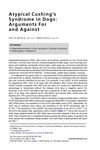Pituitary-Dependent Hyperadrenocorticism in a Terrier Dog: A Case Report
June 2016
in “
Journal of Coastal Life Medicine
”
TLDR The terrier dog with pituitary-dependent hyperadrenocorticism was successfully treated with mitotane.
A 10-year-old female terrier dog was diagnosed with pituitary-dependent hyperadrenocorticism, presenting symptoms such as polyphagia, weight gain, polyuria, polydipsia, hair loss, and exercise intolerance. Physical examination revealed abdominal distention, symmetric alopecia, thin skin, comedones, bruising, hyperpigmentation, and calcinosis cutis. Laboratory tests indicated stress leukogram, elevated serum alkaline phosphatase, hypercholesterolemia, hypertriglyceridemia, and hyperglycemia. Radiographs showed mild lung patterns and hepatomegaly, while ultrasonography revealed normal-sized adrenal glands. The condition was confirmed with a low-dose dexamethasone suppression test, and the dog was successfully treated with mitotane.





